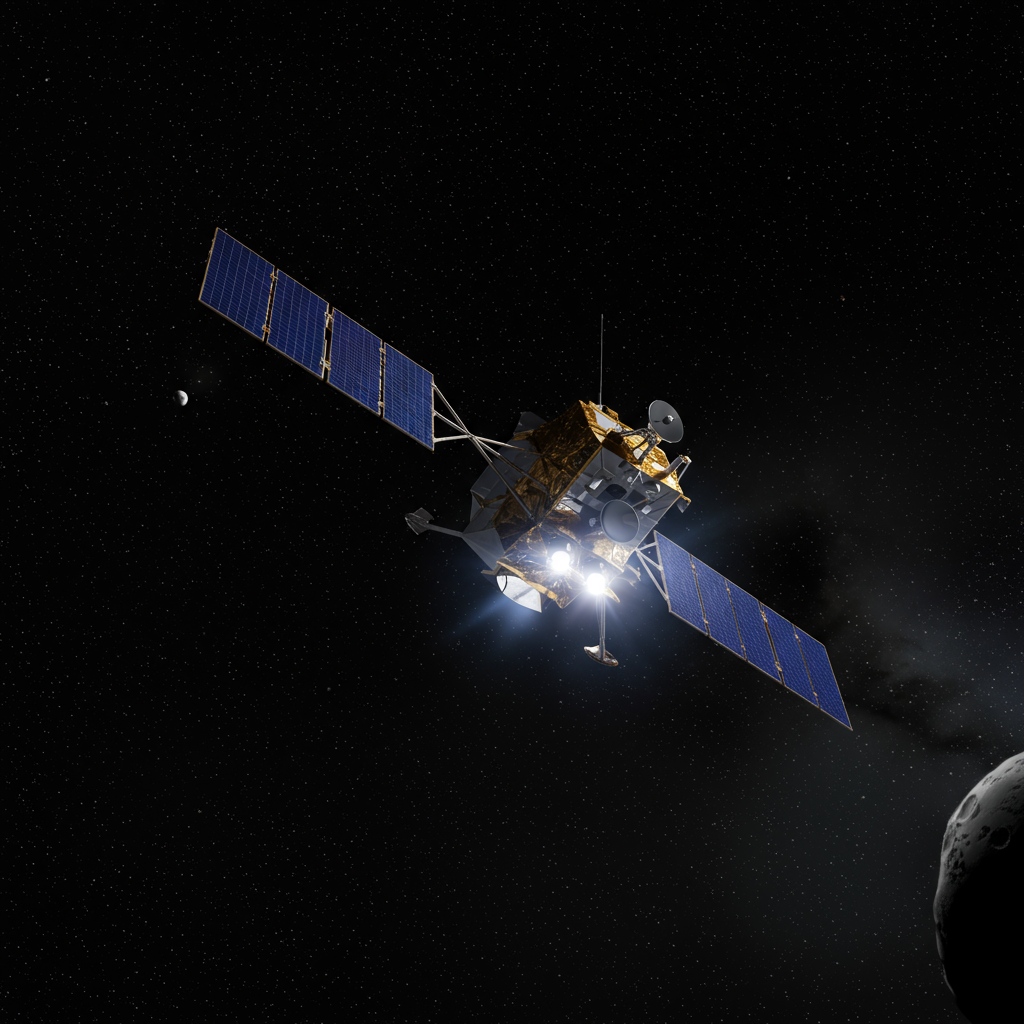Our solar system has a new, fleeting visitor – an exceptionally rare interstellar object, designated 3I/atlas (formally C/2025 N1). Discovered hurtling through space on a trajectory that confirms its origin far beyond our stellar neighborhood, this marks only the third time astronomers have definitively tracked an object passing through our solar system that didn’t originate here. This “rogue” comet offers scientists an unprecedented, close-up look at material from another star system.
Astronomers estimate that thousands of such objects might journey through our solar system at any given moment. However, most are likely too small or too dim for current telescopes to spot. The detection of 3I/Atlas underscores the increasing capabilities of modern astronomical surveys and the potential for exciting future discoveries.
What is 3I/Atlas and Where Did it Come From?
Officially classified by the International Astronomical Union’s Minor Planet Center (MPC) on July 2, 2025, 3I/Atlas was initially detected just the day before, on July 1, by the NASA-funded ATLAS (Asteroid Terrestrial-impact Last Alert System) survey operating in Hawaii. Its temporary name was A11pl3Z.
The key to confirming its interstellar nature lies in its trajectory. Unlike typical comets or asteroids bound by the Sun’s gravity into orbits, 3I/Atlas is moving at a speed that proves it’s not tethered to our star. It arrived from interstellar space and is now rapidly moving back out again. Astronomer Richard Moissl of the European Space Agency explained, “It’s not orbiting our star, but coming from interstellar space and flying off to there again.” These objects are thought to form within distant star systems and later get ejected, perhaps through gravitational interactions with passing stars, sending them on lonely journeys across the galaxy. As Harvard-Smithsonian Center for Astrophysics astronomer Jonathan McDowell put it, “We think that probably these little ice balls get formed associated with star systems. And then as another star passes by, tugs on the ice ball, frees it out. It goes rogue, wanders through the galaxy, and now this one is just passing us.”
Unpacking the Characteristics of Comet 3I/Atlas
The designation “3I” signifies that this is the third confirmed interstellar (I) object. Unlike the first, ‘Oumuamua, which baffled scientists with its unusual, elongated shape and lack of cometary activity, 3I/Atlas behaves much more like a traditional comet.
Observations show the object exhibits a faint coma and tail, giving it a “fuzziness.” According to Jonathan McDowell, “The fact that we see some fuzziness suggests that it is mostly ice rather than mostly rock.” This cometary activity provides crucial clues about its composition. Scientists believe 3I/Atlas is primarily made of ice and dust, material likely preserved from the birth of its home star system.
Estimating the size of such a distant, fast-moving object is challenging. Based on its observed brightness, experts like Richard Moissl suggest the object could range in size from 10 to 20 kilometers wide. However, he noted that this could be an overestimate if the object is smaller but highly reflective due to a very icy surface. If the upper end of this estimate is accurate, 3I/Atlas could potentially be the largest interstellar object discovered to date.
A Rapid, Harmless Journey Through Our Solar Neighborhood
One of the most striking characteristics of 3I/Atlas is its immense speed. The object is currently traveling at over 60 kilometers per second, which translates to approximately 37 miles per second. Mark Norris, an astronomer at the University of Central Lancashire, highlighted this, stating the new comet is “moving considerably faster than the other two extra-solar objects that we previously discovered,” referring to ‘Oumuamua and 2I/Borisov. This high velocity is characteristic of objects not bound to the Sun.
Scientists have precisely calculated its trajectory. Richard Moissl confirmed it poses no threat to Earth. “It will fly deep through the Solar System, passing just inside the orbit of Mars, but will not hit our neighbouring planet,” he stated. Its closest approach to the Sun, known as perihelion, is expected in October 2025, at a distance of roughly 2 AU (twice the Earth-Sun distance). By April 2026, projections suggest 3I/Atlas could reach a velocity of 90 km/s relative to Earth, potentially setting a record for the fastest interstellar object flyby detected. Its path just inside Mars’ orbit is close enough that the Mars Reconnaissance Orbiter (MRO) might even have a chance to detect it.
Observing the Interstellar Visitor
Though currently very dim, with a visual magnitude around 18.8, 3I/Atlas is expected to brighten considerably. Astronomers predict it will become brighter and closer to the Sun until late October 2025. By August, it might reach magnitude 16, potentially putting it within reach of advanced amateur telescopes. Astrophotographer Filipp Romanov and other amateur and professional astronomers have already captured images and confirmed its presence.
Locating 3I/Atlas requires knowing its position. At the time of initial reporting, it was roughly the same distance from Earth as Jupiter but was only visible from the Southern Hemisphere. Astronomer Eddie Irizarry has provided specific star charts detailing its projected path, which will take it through the constellation Sagittarius and near star clusters like M3. The object is expected to remain observable with powerful telescopes into the following year as it continues its journey back out into interstellar space.
The Rarity and Future of Interstellar Object Detection
The discovery of 3I/Atlas is significant because it’s only the third such confirmed object. The first, ‘Oumuamua (1I/2017 U1), was detected in 2017 and sparked widespread interest, including speculative theories later ruled out. The second, comet 2I/Borisov, followed in 2019. Each new detection provides unique data points, helping scientists understand the population and characteristics of objects traveling between stars.
Models suggest that many more interstellar objects exist within the solar system’s reach than we’ve detected so far. Estimates range up to 10,000 objects potentially present at any one time, though most are likely very small and faint. The good news for astronomers is that the next generation of telescopes, such as the powerful Vera C. Rubin Observatory in Chile, are specifically designed to survey large areas of the sky rapidly and deeply. These new facilities are expected to dramatically increase our chances of discovering many more interstellar visitors in the coming years.
Scientific Value: A Sample from Another Star System
Despite its rapid passage making a dedicated space mission to 3I/Atlas impossible with current technology, astronomers are emphasizing the immense scientific value of studying it remotely. Observing its composition, studying the gases and dust in its coma and tail, and tracking its behavior provides a direct sample of material from another planetary system. This offers unique insights into how other star systems form and the types of building blocks they contain, something that typically requires studying distant exoplanets indirectly.
Beyond understanding planetary formation, these objects hold profound implications for astrobiology – the study of life in the universe. Scientists are keen to see if future observations could detect complex organic molecules, such as amino acids, which are considered precursors to life. Mark Norris noted the potential impact of such a discovery: “A lot more confidence that the conditions for life exist in other star systems,” if signs of life’s building blocks were found on one of these “cometos” (a blend of comet and object). While detecting amino acids directly on 3I/Atlas remotely is unlikely with current means, the potential highlights the scientific importance of every interstellar visitor. They truly are rare messengers from the cosmos, offering clues about the universe beyond our Sun’s influence.
Frequently Asked Questions
What is 3I/Atlas and why is it significant?
3I/Atlas, officially C/2025 N1, is a comet that originated from outside our solar system. It is classified as an “interstellar object” because its speed and trajectory confirm it is not bound by the Sun’s gravity. Its significance lies in its rarity; it’s only the third such object ever confirmed entering our solar system. Studying it remotely provides astronomers with a unique sample of material from another star system, offering insights into how other planetary systems form and their potential composition.
How big and fast is 3I/Atlas, and is it a threat to Earth?
Astronomers estimate 3I/Atlas is likely between 10 and 20 kilometers in diameter, potentially making it the largest interstellar object detected so far. It is currently traveling at over 60 kilometers per second (about 37 miles per second), significantly faster than previous interstellar visitors. Despite its size and speed, scientists confirm it poses no threat to Earth. Its calculated trajectory will take it just inside the orbit of Mars, passing safely through the inner solar system before heading back out into interstellar space.
Can I see the interstellar comet 3I/Atlas?
As of initial reporting, 3I/Atlas was very dim (visual magnitude ~18.8) and only visible from the Southern Hemisphere, requiring powerful telescopes. However, it is expected to brighten as it approaches the Sun, potentially reaching magnitude 16 by August 2025 and continuing to brighten until late October. With advanced amateur telescopes and accurate star charts, it might become observable for dedicated skywatchers in the Southern Hemisphere, and possibly other regions later depending on its path. It is expected to remain observable by professional telescopes into 2026.
Conclusion
The brief visit of 3I/Atlas through our solar system represents an extraordinary opportunity for astronomers. As the third confirmed interstellar object, and potentially the largest and fastest yet observed, it provides invaluable data points on these cosmic nomads. While a direct mission is impossible, remote observations using powerful telescopes are underway, offering a chance to study material from a distant star system firsthand. The discovery highlights the increasing sophistication of our sky surveys and fuels anticipation for future detections by next-generation telescopes like the Vera C. Rubin Observatory. Each interstellar object is a precious sample, carrying clues about the vast, diverse universe beyond our home, and holding the potential to shed light on fundamental questions about cosmic origins and the potential for life elsewhere. Scientists will continue to watch 3I/Atlas closely as it makes its rapid, unique passage.




